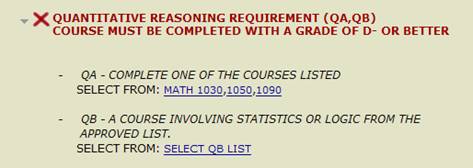

|
 dars reports help dars reports help  |
| What is DARS? | ||
| DARS is the Degree Audit Reporting System. DARS assists the advising process and greatly simplifies the preparation of student graduation audits. The DARS audit is an advising report that shows progress toward a degree. Students can request a degree audit report, at no cost through the Web, for the degree program(s) in which they are enrolled or for degree programs in which they are interested. DARS takes the guess work out of selecting courses for future enrollment. | ||
| What does DARS show? | ||
| University major and graduation (i.e. general education and university bachelor degree) requirements are displayed and DARS shows which of these requirements the student has already fulfilled and which remain to be completed. The report has instructions for easy interpretation. Students can print copies and take it with them when they see their academic advisors. | ||
| How do I get my DARS report? | ||
| Students can obtain their DARS reports from the World Wide Web at http://cis.utah.edu on any computer that has access to the Web. The reports will include instructions so they can be easily read and understood and -- they are free! | ||
| Do I still need to see an advisor? | ||
| Yes! The academic advisor will use the DARS report in the process of advising you about your program. An advisor can answer questions you may have and advise you about your course substitutions and waivers that may be needed. Some programs courses must be approved by an advisor or a department before they can be included on the report. | ||
| Is this official documentation? | ||
| No. The DARS report is an internal document used for advising and graduation certification. It is NOT an official documentation of your academic record. An official "Transcript of Academic Record" provides this documentation and can be ordered from Registrar's Office. | ||
| What if I think something is wrong with my DARS report? | ||
| If you do not feel that DARS is correctly analyzing your requirements, you should contact your departmental advisor for problems regarding your major and University College (581-8146) for problems regarding General Education and/or University bachelor degree requirements. | ||
| What about course work transferred from another school? | ||
| Transfer course equivalencies are included in DARS for Utah schools. When students request their DARS reports, transfer courses from these institutions will automatically be equated to a U of U course as outlined in the State Transfer Articulation Guide. All other transfer courses, without U of U equivalencies, are listed in the audit, but are only used to show completion of requirements such as total hours, general education, and University bachelor degree requirements. They are not used to show completion of major requirements. Students who believe that some of these transfer courses should satisfy their major requirements should see their departmental advisors. | ||
| What do the Graphs Show? | ||
Graphs will appear at the top of the audit showing GPA’s and the number of completed hours.
The first graph is a pie chart that shows how many hours the student has completed towards the 122 hour requirement. The second graph is a bar graph that will display the students University of Utah GPA.
The third set of graphs breaks up the degree program into different categories and will show how many hours a student has completed towards each category. Each of these categories can be selected to show additional information.
The fourth graph will show the GPA for each category listed in the graph to the left. If a student has not completed any classes in the category no graph will appear.
| ||
| What do the colors mean in the graphs? | ||
| All graphs are color coded to show completed, in progress and unfulfilled hours. The colors mean the following:
| ||
| How do I know where I am at in the audit? | The top left corner of the audit will have a trail of where you are at. At any time the links can be selected to return to main audit page. Text above the graphs will also indicate what level you are at in the graph.
| |
| What are the components of a DARS report? | ||
A DARS report is usually displayed in the following order:


|
||
| How do I print my DARS report ? | A DARS report can be printed by selecting the printer friendly button below the graphs on the right. |